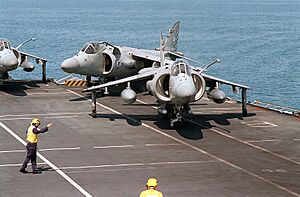Harrier Jump Jet facts for kids


The Harrier Jump Jet, often just called the Harrier, is a special British-designed military airplane. It was first made in the 1960s. What makes the Harrier famous is its ability to take off and land straight up and down, like a helicopter! It does this by changing the direction of its powerful thrust from its engines. This amazing ability is called V/STOL, which means "Vertical/Short Takeoff and Landing." While it can take off vertically, it can carry much heavier loads if it uses a short runway for takeoff.
Contents
How the Harrier Was Developed
In 1967, a company called Bristol Engine Company came up with a new idea for an engine that could direct its thrust in different ways. After this, Hawker Aircraft designed an airplane that could meet the needs of NATO (North Atlantic Treaty Organization) for a "light tactical support fighter." Even though the British government didn't provide money at first, NATO helped fund the project.
The very first test plane flew in 1960. Over time, many changes were made, and different early versions were tested, including one called the "Kestrel." The first Harriers officially started flying for the RAF (Royal Air Force) and Royal Navy in 1969. These planes were built in both Britain and the United States.
Later, the Harrier was improved and built by companies like British Aerospace and Macdonald Douglas. These companies are now part of BAE Systems and Boeing. Today, the Boeing/BAE Systems AV-8B Harrier II is used by NATO countries such as the United States, Spain, and Italy. The Royal Air Force and Royal Navy use a special version called the BAE Systems/Boeing Harrier II.
Between 1969 and 2003, 824 different types of Harrier planes were made. Making brand new Harriers stopped in 1997. The very last improved Harrier (called the Harrier II Plus) was delivered in December 2003. This marked the end of the Harrier production line.
Countries That Use the Harrier
Many different military forces around the world use the Harrier. The United States Marine Corps and the Royal Air Force (RAF) use versions of the Harrier that are specially made for taking off and landing on aircraft carriers, which are huge ships that act like floating airfields. Other countries that fly the Harrier include Thailand and India.
In 2006, the RAF started using a newer version of the Harrier called the GR/9. This was an updated model of the older GR/7. It can fly very fast, reaching speeds of up to 574 knots (about 660 miles per hour or 1,063 kilometers per hour).
The Harrier was used a lot during the Falklands War in 1982. Harrier jets flew a total of 1,561 missions during the conflict. They successfully shot down 20 enemy planes, with three more possibly shot down. Sadly, 10 Harriers were lost during the war. Six of these were shot down by the enemy, while the others were damaged in accidents on the aircraft carriers. The Sea Harriers played a very important role in making the Argentine Air Force much less effective than they had hoped to be.
What Equipment the Harrier Carries
The Harrier can carry different types of equipment depending on what its mission is. It can carry powerful missiles and bombs to use in combat. It can also carry special cameras to take pictures of the ground from high above, which is useful for spying or mapping.
Images for kids
-
A RAF Harrier GR9 arriving at the RIAT airshow in 2008.
See also
 In Spanish: Harrier para niños
In Spanish: Harrier para niños












